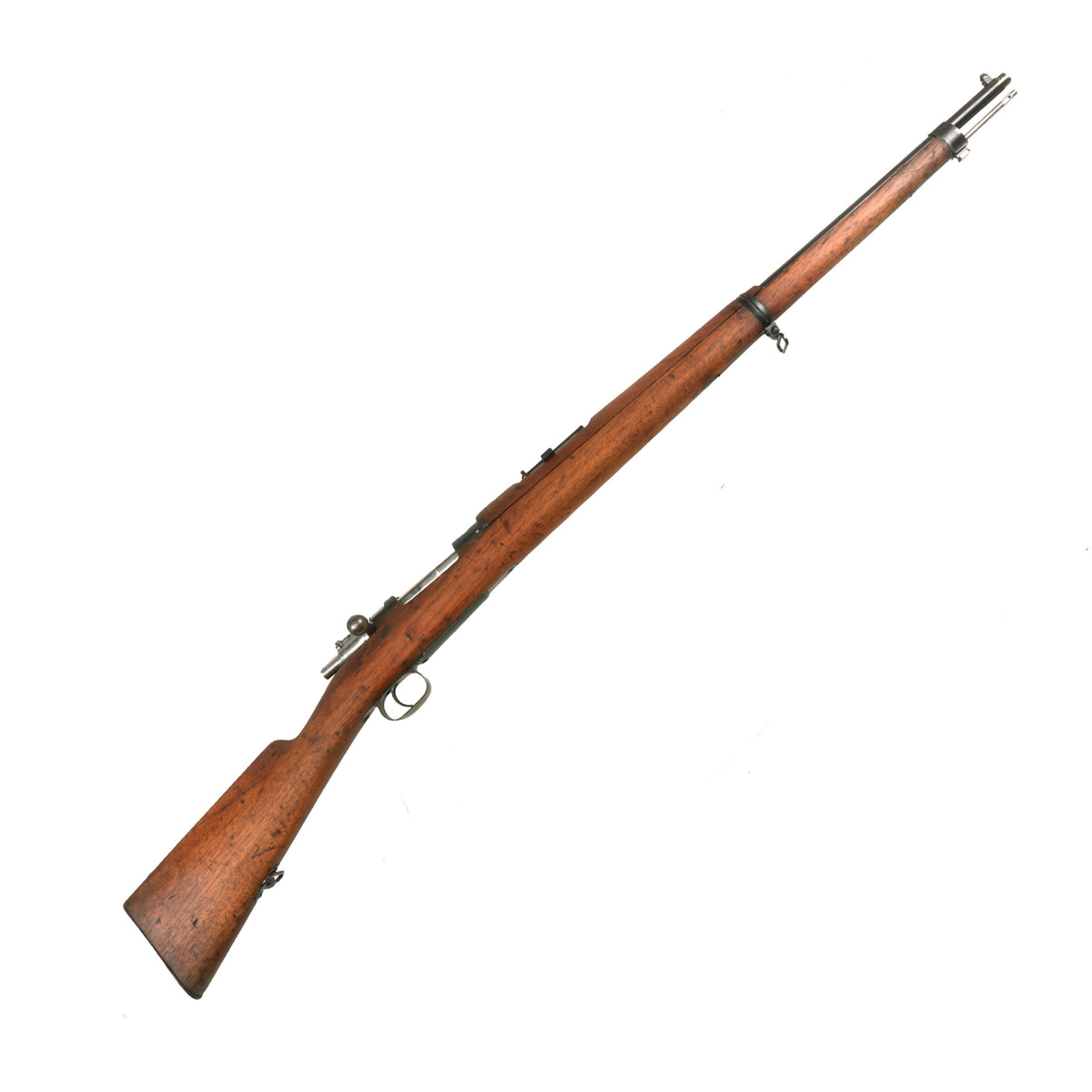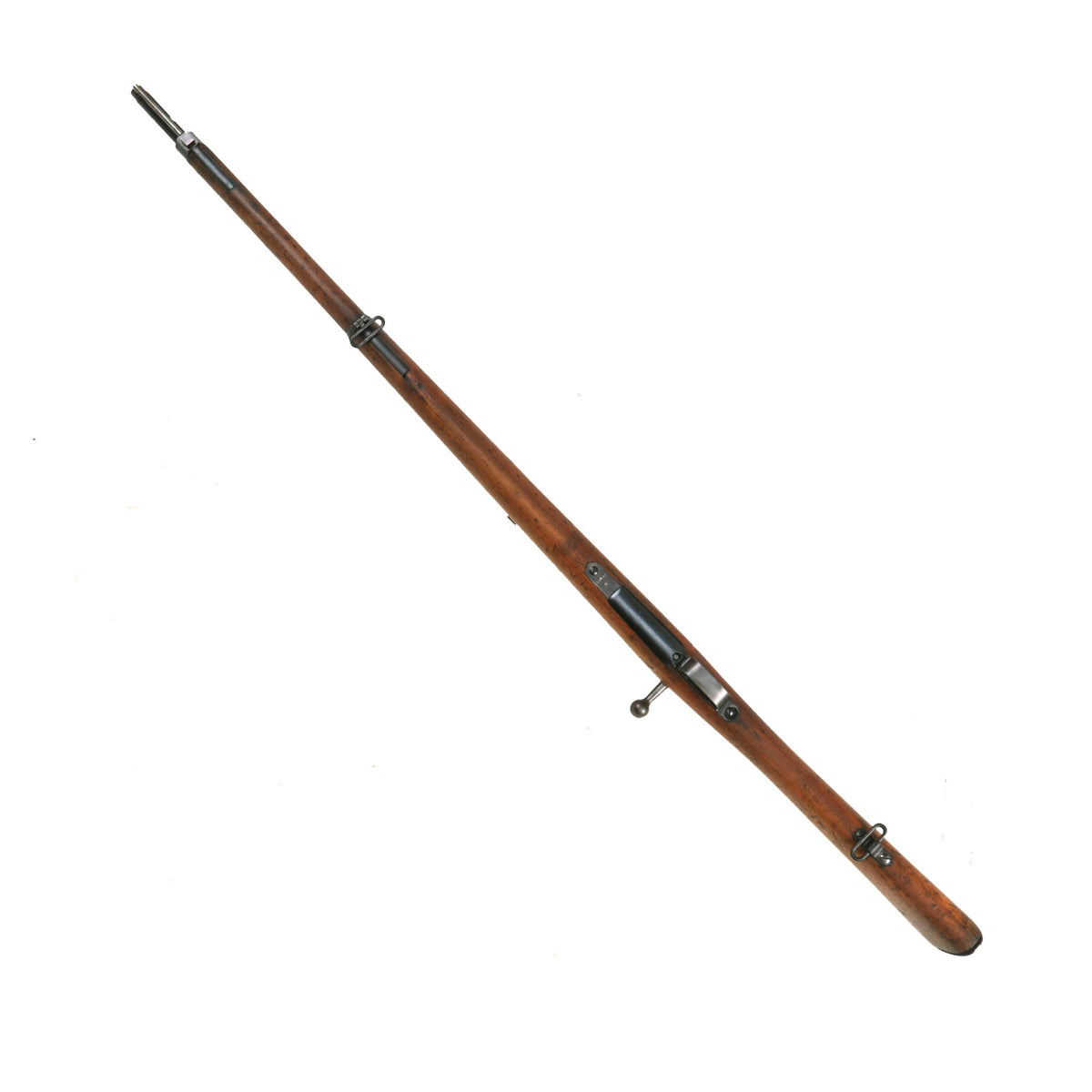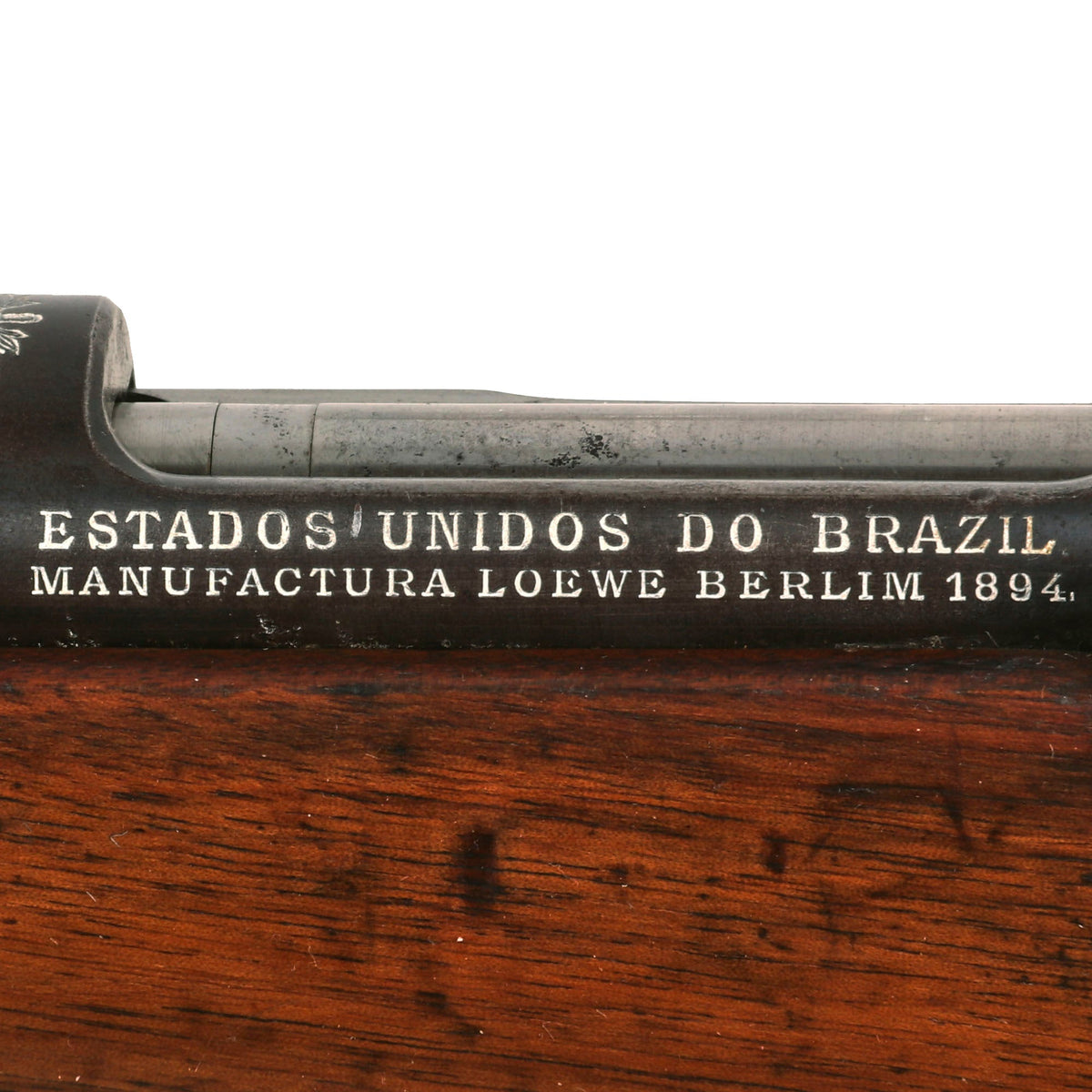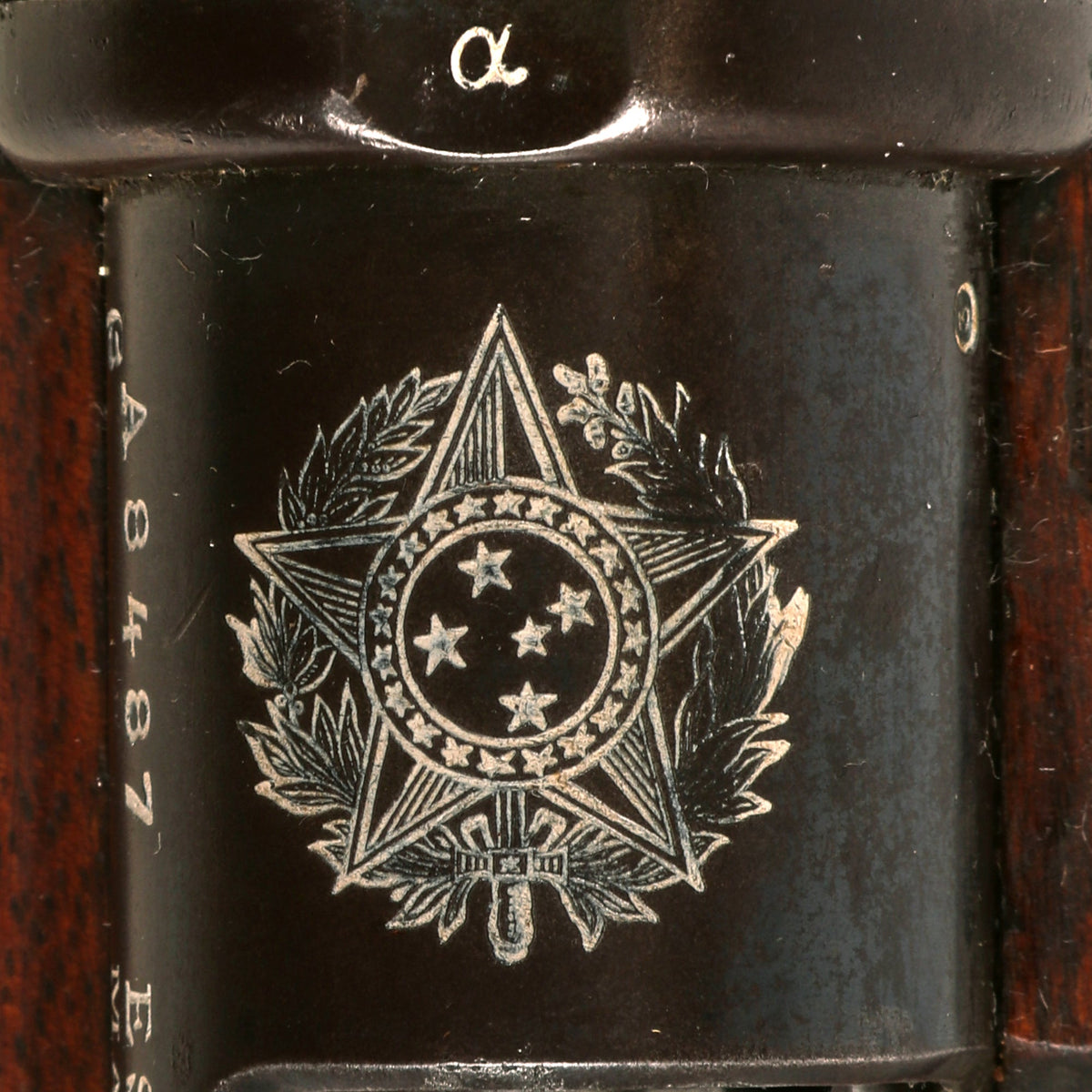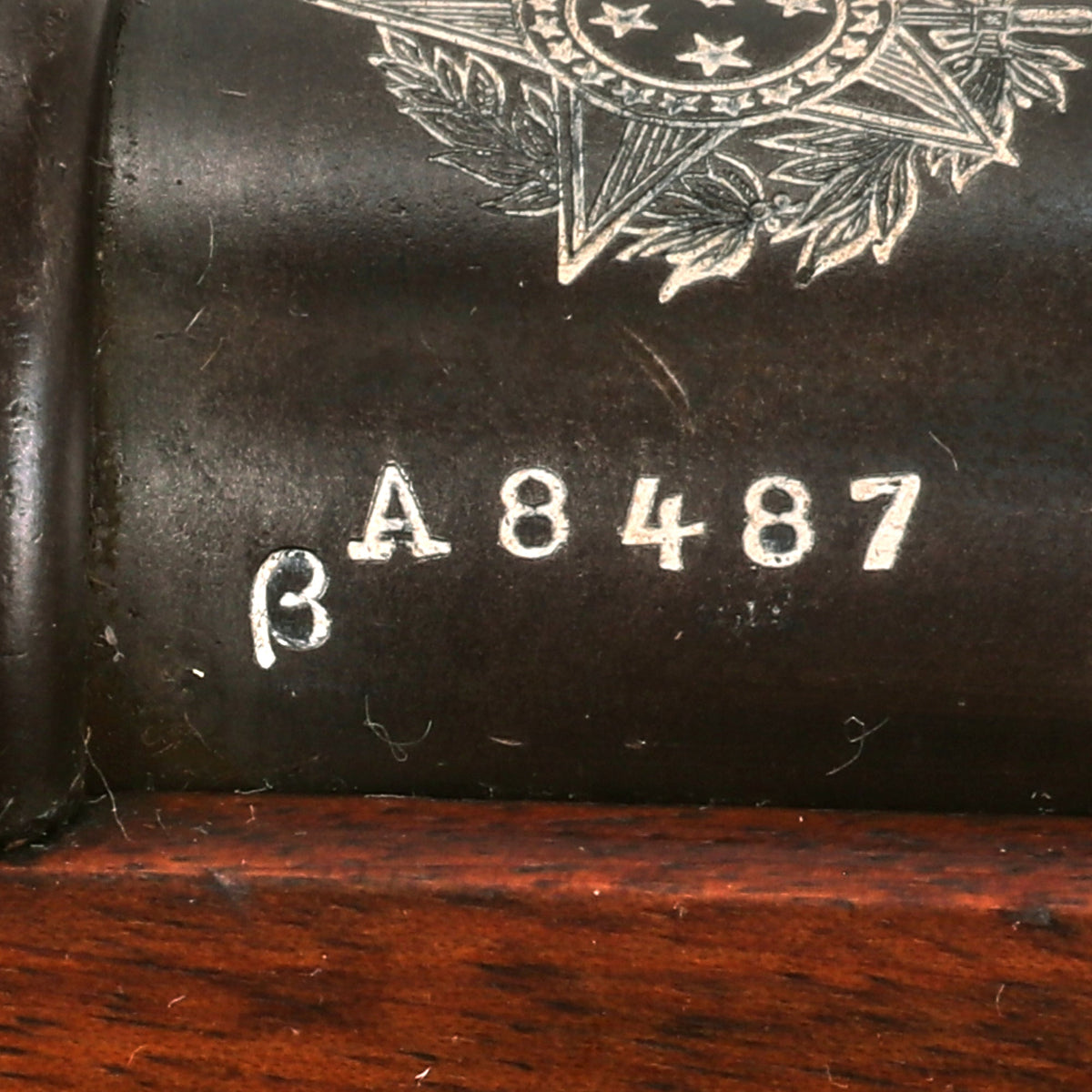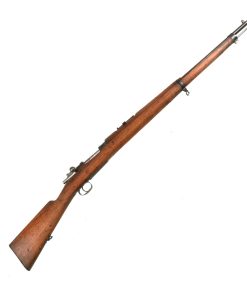Original Antique German Model 1894 Brazilian Contract Mauser Rifle by Ludwig Loewe Berlin – Serial A8487 Original Items
$ 1.095,00 $ 273,75
Original Item: Only One Available. The Mauser Model 1893 is a bolt-action rifle commonly referred to as the Spanish Mauser, though the model was adopted by other countries in other calibers, most notably the Ottoman Empire. The M1893 was based on the experimental M1892 rifle, which Paul Mauser developed for the Spanish Army as part of a program to correct deficiencies in the earlier 1889, 1890, and 1891 series of Mauser rifles. The M1893 introduced a short staggered-column box magazine that fit flush with the bottom of the stock; the magazine held five smokeless 7×57mm Mauser rounds, which could be reloaded quickly by pushing a stripper clip from the top of the open bolt.
The M1893 proved to be a major worldwide success for Mauser, as it provided the basis for later developments, including the Models 1894 and 1896—commonly referred to as Swedish Mausers—the Model 1895, and ultimately the Gewehr 98, one of the most successful bolt-action rifle designs ever produced. For his work, Mauser received the Grand Cross of the Order of Military Merit from Spain. The marked superiority of the M1893 over its American opponent in the Spanish–American War, the Krag–Jørgensens, led the US Army to develop the M1903 Springfield, which itself heavily copied Mauser’s designs.
In addition to Mauser, the Spanish 1893 rifles were manufactured under license by a variety of other firms, including Ludwig Loewe & Company (and its successor, Deutsche Waffen und Munitionsfabriken) of Germany, Fabrique Nationale of Belgium, and Fábrica de Armas and Industrias de Guerra de Cataluna of Spain. Most of these were simply license-made clones, however a slightly modified M1893 rifle was also sold to Brazil, chambered in 7 mm and designated M1894. Produced in long rifle and carbine version, it was used during the War of Canudos in 1897 and later during the Contestado War alongside the Mauser Model 1908.
These were initially produced by Fabrique Nationale, however the owner of the Mauser patents, Ludwig Loewe & Co., objected to the company making these export rifles. While they had licensed the patents, Loewe claimed that the license it granted to FN was limited to making and selling M1889 rifles to the Belgian Army. Eventually a deal was struck, with Ludwig Loewe and later D.W.M. taking over the supply to Brazil and other South American Countries.
The Ludwig Loewe company was actually part owner of Mauser Waffenfabrik from 1887 onward, which is why they were the primary contractor for the export Mauser rifles. In 1896 the company consolidated its arms manufacturing, and founded Deutsche Waffen- und Munitionsfabriken, the famous D.W.M.. All rifles made 1897 onward were marked with the new company abbreviation. Therefore ANY LUDWIG LOEWE marked firearm is considered a pre-1899 ANTIQUE by U.S. FEDERAL LAW. Many Brazilian Contract M-1894 Rifles and Carbines found today are marked DWM, with examples by Ludwig Loewe being hard to find.
Here we have a very nice German-made Brazilian Contract M1894 Infantry rifle, in the standard 7×57mm Mauser chambering. It is an early example by Ludwig Loewe, and has the correct Coat of Arms of the First Brazilian Republic over the chamber, with the maker marking and model on the left side:
ESTADOS UNIDOS DO BRAZIL
MANUFACTURA LOEWE BERLIM 1894.
Of note is that “Berlim” is the Portuguese spelling of “Berlin”. On the left side of the receiver is serial number A8487, which is also stamped on the magazine housing and very faintly on the left side of the stock. The other components of the rifle such as the bolt and cleaning rod are non matching, typical of a rifle that has seen long use in service, and was probably serviced at arsenal multiple times. This is only the second example we have had a Brazilian contract Mauser, and the first made by Loewe. There are various other proofs on the rifle such as Greek letters α and β, and the markings have been highlighted in white to make them easier to see.
In generally tight condition this rifle has certainly seen some service but still looks great, with a lovely service worn stock. The stock does look to have been reconditioned at arsenal, which has made the original inspection cartouches faint. The metalwork is in very good condition, with the original bluing very well retained, except on the butt plate which shows wear. There is even much of the the “Niter Blue” color on the magazine follower, and the bolt release. The bright steel bolt and cleaning rod are just lovely, showing just a bit of light staining.
The rifle cycles great, with no issues that we can see. The “wing” safety is fully functional, working exactly as intended with no mechanical issues to note. It prevents firing in the “up” position, and prevents both cycling and firing in the “right” position. The bolt release works correctly, allowing easy field stripping of the rifle. The rear sight is present and fully functional, and both sling swivels are still present, as is the cleaning rod. The bore is in very good condition, with crisp lands and grooves and a mostly bright finish. It shows little wear, with just a bit of overall oxidation haze from age and use.
A very nice example of a legendary Mauser design, with an interesting production history. In lovely condition and ready to display!
Specifications-
Years of Manufacture: 1894-1897
Caliber: 7×57mm Mauser
Cartridge Type: Centerfire Cartridge
Barrel Length: 29 Inches
Overall Length: 48 1/2 Inches
Action type: Bolt-Action
Feed System: 5 round internal magazine
Fast Shipping with Professional Packaging
Thanks to our longstanding association with UPS FedEx DHL, and other major international carriers, we are able to provide a range of shipping options. Our warehouse staff is expertly trained and will wrap your products according to our exact and precise specifications. Prior to shipping, your goods will be thoroughly examined and securely secured. We ship to thousands clients each day across multiple countries. This shows how we're dedicated to be the largest retailer on the internet. Warehouses and distribution centres can be located throughout Europe as well as the USA.
Note: Orders with more than one item will be assigned a processing date depending on the item.
Before shipping before shipping, we'll conduct a thorough inspection of the items you have ordered. Today, the majority of orders will be delivered within 48 hours. The delivery time will be between 3-7 days.
Returns
The stock is dynamic and we cannot completely manage it because multiple stakeholders are involved, including our factory and warehouse. So the actual stock may alter at any time. It's possible that you may not receive your order once the order has been made.
Our policy is valid for a period of 30 days. If you don't receive the product within 30 days, we are not able to issue a refund or an exchange.
You can only return an item if it is unused and in the same state as the day you received it. You must have the item in its original packaging.
Related products
Uncategorized
Uncategorized
Band of Brothers ORIGINAL GERMAN WWII Le. F.H. 18 10.5cm ARTILLERY PIECE Original Items
Uncategorized
Uncategorized
Uncategorized
Angolan Rebel 1970s era 60mm Inert Display Mortar from Angolan Civil War Original Items
Uncategorized
Uncategorized
Uncategorized
Australian WWII Owen MK1 Machine Carbine SMG Custom Fabricated Replica with Sling Original Items
Uncategorized
Uncategorized
Uncategorized
Armored Burgonet Helmet & Polearm from Scottish Castle Leith Hall Circa 1700 Original Items
Uncategorized
Uncategorized
Uncategorized
Armoured Fighting Vehicles of the World: AFVs of World War One (Hardcover Book) New Made Items
Uncategorized
Uncategorized
Uncategorized
Uncategorized
Uncategorized
